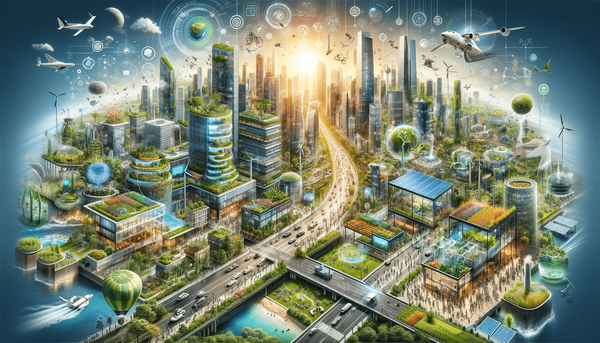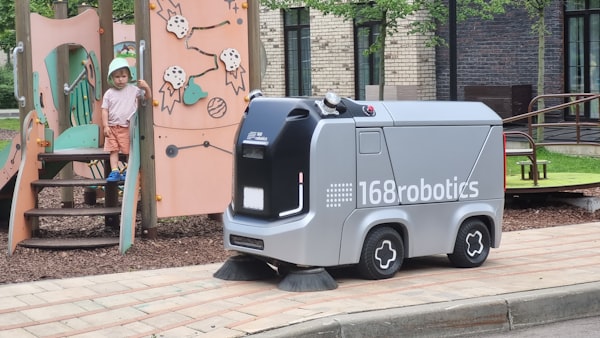Digitalization, Industry 4.0, and AI drive a sustainable, circular economy.
Dive into how digitalization and AI drive sustainable, circular economic practices.

The research paper "Benefits and Impacts of the Digitalization for a Sustainable Future: An Approach to Circular Economy and Industry 4.0" explores the intersection of digitalization, circular economy, and Industry 4.0 and how these can be harnessed for a more sustainable future[1].
Digitalization, Circular Economy, and Industry 4.0
The paper highlights the transformative capabilities of digitalization, which has permeated every facet of our society and economy, shaping the landscape in which businesses operate and society functions[1]. Concurrently, the principles of the circular economy, emphasizing waste reduction and sustainable resource utilization, have gained prominence as a guiding framework for responsible and resilient business practices[1].
Industry 4.0, the next evolutionary phase of manufacturing systems, unlocks new models and methodologies that transform traditional manufacturing into smart systems[1]. Artificial Intelligence (AI) emerges as a critical enabler in analyzing vast datasets, playing a pivotal role in facilitating a systematic shift and driving sustainable practices in the industry[1].
Consumers and Digitalization
The paper also discusses the role of consumers in the digitalization process. The increase in population and the growth of the "middle class" have led to the emergence of an increasingly demanding consumer society[1]. Consumers' attitudes toward sustainability related to using, washing, repairing, and renting products are important factors to consider when aiming to build a circular economy and foster a culture of responsible waste processing and recycling[1].
Industry 4.0, AI, and Circular Economy Integration
Industry 4.0, or the Fourth Industrial Revolution (4IR), plays a crucial role in the Circular Economy (CE) by monitoring products, transmitting real-time data, and providing accurate information about product conditions and availability[1]. The rise of Industry 4.0 technologies, such as Big Data, Artificial Intelligence, the Internet of Things, and 3D printing, are building a pathway for businesses to transition toward circular models[1].
Transition Challenges and Solutions
Companies transitioning to Circular Economy face challenges integrating the Fourth Industrial Revolution (4IR) technologies. These challenges include high implementation costs and the need for a workforce with specialized skills[1]. Mitigations to these challenges can include implementing collaborative research and development among industry players, research institutions, and government bodies and training programs to upskill existing employees and attract new talent with the required expertise in digital technologies and circular economy practices[1].
AI as Predictive Decision-Making
AI's ability to precisely predict product demands facilitates more accurate decision-making on material reuse. This capability contributes to a more sustainable and circular approach to manufacturing[1].
Resource Efficiency and After-Sales Services
AI aids in circular product design by providing precise data on resources, reducing resource consumption, and increasing material productivity. Sensors in AI-powered products enable monitoring performance and maintenance requirements, enhancing after-sales services[1].
Waste Prevention through AI
AI's role is to identify potential failures in processes and operations, helping prevent waste generation. Collecting data on operations aids in identifying and preventing situations leading to waste[1].
Conclusions
The confluence of Circular Economy, Industry 4.0, and Artificial Intelligence heralds a new era for the industry. This synergy is not merely a convergence of technologies but a strategic alliance that addresses environmental concerns, empowers sustainable product design, and propels the industry toward a circular and intelligent future[1].
The benefits are evident in environmental conservation, economic efficiency, social responsibility, and technological advancements. As challenges are met with innovative solutions, the industries stand poised to lead the way in the global shift towards a more sustainable, efficient, and circular manufacturing landscape[1].
Engaging members of society in circular economy initiatives is also crucial to ensure the resilience of a sustainable global system. Their behavior poses the most significant challenge to successful implementation, not merely due to the stress induced by their demand for goods and services but also because the effectiveness of technology hinges on its judicious integration within industries. This responsibility rests squarely on the shoulders of individuals[1].
In this context, fostering a collective understanding of the symbiotic relationship between societal actions and technological advancements becomes a linchpin for achieving lasting success in pursuing a circular and sustainable future[1].
Citations:
[1]
[2] https://www.researchgate.net/publication/377066494_Benefits_and_Impacts_of_the_Digitalization_for_a_Sustainable_Future_An_Approach_to_Circular_Economy_and_Industry_40
[3] https://www.emerald.com/insight/content/doi/10.1108/REGE-07-2021-0121/full/html
[4] https://whatfix.com/blog/digital-transformation-challenges/
[5] https://www.linkedin.com/pulse/pros-cons-technology-balancing-innovation-rahul-khanna
[6] https://www.frontiersin.org/articles/10.3389/fpsyg.2022.961057
[7] https://iap.unido.org/articles/industry-40-cornerstone-circular-economy
[8] https://www.identecsolutions.com/news/11-digital-transformation-challenges-and-how-to-overcome-them
[9] https://environmental-conscience.com/green-technologies-pros-cons/
[10] https://www.mdpi.com/2071-1050/15/20/14697
[11] https://www.linkedin.com/pulse/industry-40-circular-economy-new-paradigm-logistics-hellmuth-sander
[12] https://pecb.com/article/digital-transformation-challenges-and-how-to-overcome-them
[13] https://www.sciencedirect.com/science/article/pii/S2199853123001191
[14] http://portal.amelica.org/ameli/journal/154/1543324007/html/
[15] https://www.forbes.com/sites/bernardmarr/2023/10/12/the-impact-of-digital-transformation-on-business-models-opportunities-and-challenges/
[16] https://www.sciencedirect.com/science/article/pii/S0048969721036111
[17] https://www.sciencedirect.com/science/article/pii/S0959652621031371
[18] https://pixelplex.io/blog/digital-transformation-challenges/
[19] https://www.ncbi.nlm.nih.gov/pmc/articles/PMC9748610/
[20] https://onlinelibrary.wiley.com/doi/full/10.1002/sd.2542
[21] https://www.nist.gov/blogs/manufacturing-innovation-blog/7-manufacturing-digitization-challenges-and-how-overcome-them
[22] https://link.springer.com/article/10.1007/s10796-023-10406-5
[23] https://circulareconomyalliance.com/product/circular-industry-4-0-redesigning-the-future/
[24] https://enterprisersproject.com/article/2023/4/digital-transformation-roadblocks
[25] https://www.researchgate.net/publication/345144783_Circular_Economy_and_Industry_40_One-Way_or_Two-way_Relationships




